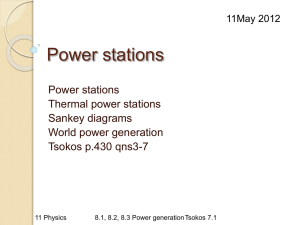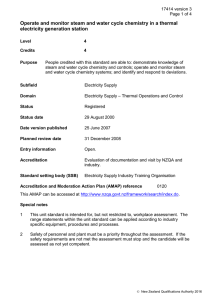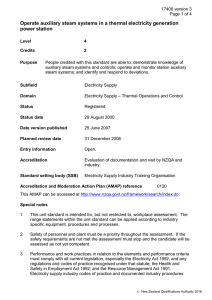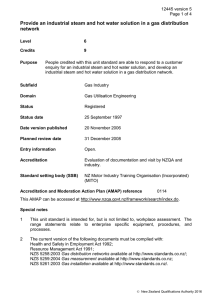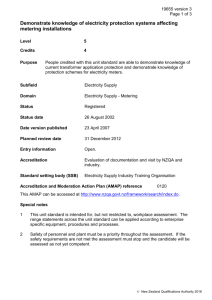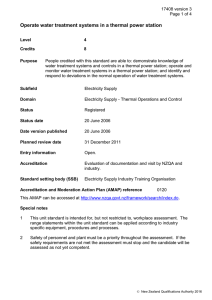Operate steam raising equipment from a thermal electricity generation control room
advertisement
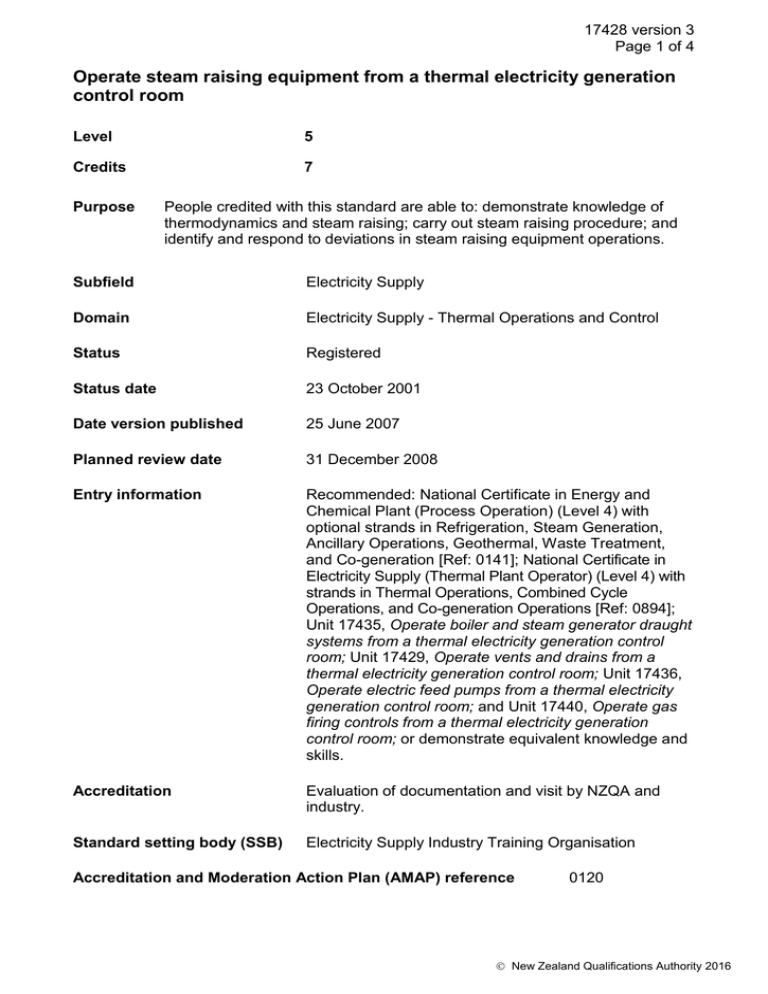
17428 version 3 Page 1 of 4 Operate steam raising equipment from a thermal electricity generation control room Level 5 Credits 7 Purpose People credited with this standard are able to: demonstrate knowledge of thermodynamics and steam raising; carry out steam raising procedure; and identify and respond to deviations in steam raising equipment operations. Subfield Electricity Supply Domain Electricity Supply - Thermal Operations and Control Status Registered Status date 23 October 2001 Date version published 25 June 2007 Planned review date 31 December 2008 Entry information Recommended: National Certificate in Energy and Chemical Plant (Process Operation) (Level 4) with optional strands in Refrigeration, Steam Generation, Ancillary Operations, Geothermal, Waste Treatment, and Co-generation [Ref: 0141]; National Certificate in Electricity Supply (Thermal Plant Operator) (Level 4) with strands in Thermal Operations, Combined Cycle Operations, and Co-generation Operations [Ref: 0894]; Unit 17435, Operate boiler and steam generator draught systems from a thermal electricity generation control room; Unit 17429, Operate vents and drains from a thermal electricity generation control room; Unit 17436, Operate electric feed pumps from a thermal electricity generation control room; and Unit 17440, Operate gas firing controls from a thermal electricity generation control room; or demonstrate equivalent knowledge and skills. Accreditation Evaluation of documentation and visit by NZQA and industry. Standard setting body (SSB) Electricity Supply Industry Training Organisation Accreditation and Moderation Action Plan (AMAP) reference 0120 New Zealand Qualifications Authority 2016 17428 version 3 Page 2 of 4 This AMAP can be accessed at http://www.nzqa.govt.nz/framework/search/index.do. Special notes 1 This unit standard is intended for, but not restricted to, workplace assessment. The range statements within the unit standard can be applied according to industry specific equipment, procedures and processes. 2 Safety of personnel and plant must be a priority throughout the assessment. If the safety requirements are not met the assessment must stop and the candidate will be assessed as not yet competent. 3 Performance and work practices in relation to the elements and performance criteria must comply with all current legislation, especially the Electricity Act 1992, and any regulations and codes of practice recognised under that statute; the Health and Safety in Employment Act 1992; and the Resource Management Act 1991. Electricity supply industry codes of practice and documented industry procedures include the Safety Manual – Electricity Industry (SM-EI) (2004) Wellington: Electricity Engineers’ Association. A full list of current legislation and industry codes is available from the Electricity Supply Industry Training Organisation, PO Box 1245, Hamilton. 4 ‘Industry requirements’ include all the documented workplace policies, procedures, specifications, business and quality management requirements relevant to the workplace in which assessment is carried out. 5 The term ‘operate’ is defined as the remote operation, testing and commissioning of main and auxiliary thermal plant systems associated with large steam/electrical generation plant from a control room environment. Elements and performance criteria Element 1 Demonstrate knowledge of thermodynamics and steam raising. Performance criteria 1.1 Basic thermodynamics are explained in accordance with industry requirements. Range 1.2 includes but is not limited to – specific heat capacity, saturation temperature, latent heat, dryness fraction, superheat, entropy, enthalpy, supercritical, steam tables, heat transfer. Preparations to fire the boiler/steam generator are explained in accordance with industry requirements. Range includes but is not limited to – pre-start checks, drains, boiler fill and vent, chemical requirements. New Zealand Qualifications Authority 2016 17428 version 3 Page 3 of 4 1.3 Steam raising is described in accordance with industry requirements. Range includes but is not limited to – methods of circulation, boiling point, steam drums, steam generating section, superheating, reheating, economiser, boiler expansion. Element 2 Carry out steam raising procedure. Performance criteria 2.1 Current status of plant is identified in accordance with industry requirements. 2.2 Operations are carried out in accordance with industry requirements. Range includes but is not limited to – filling boiler, selecting burners, operating through boiling point, vent and drain operation, raising boiler pressure, drum level control, temperature control. 2.3 Actions are logged in accordance with industry requirements. 2.4 Operating decisions are determined in accordance with plant status and industry requirements. Range 2.5 includes but is not limited to – plant availability and service condition, resource consent and loading limits, impact on operations, options. Plant and equipment are monitored in accordance with industry requirements. Element 3 Identify and respond to deviations in steam raising equipment operations. Performance criteria 3.1 Deviations from normal operating conditions are identified, reported and explained in accordance with industry requirements. Range 3.2 includes but is not limited to – drum level excursions, high gas exit temperatures, high steam temperatures, loss of burners, oxygen trim deviations, chemical excursions, boiler expansion. Plant safety procedures are followed in accordance with industry requirements. Please note Providers must be accredited by NZQA, or an inter-institutional body with delegated authority for quality assurance, before they can report credits from assessment against unit standards or deliver courses of study leading to that assessment. New Zealand Qualifications Authority 2016 17428 version 3 Page 4 of 4 Industry Training Organisations must be accredited by NZQA before they can register credits from assessment against unit standards. Accredited providers and Industry Training Organisations assessing against unit standards must engage with the moderation system that applies to those standards. Accreditation requirements and an outline of the moderation system that applies to this standard are outlined in the Accreditation and Moderation Action Plan (AMAP). The AMAP also includes useful information about special requirements for organisations wishing to develop education and training programmes, such as minimum qualifications for tutors and assessors, and special resource requirements. Comments on this unit standard Please contact the Electricity Supply Industry Training Organisation info@esito.org.nz if you wish to suggest changes to the content of this unit standard. New Zealand Qualifications Authority 2016
